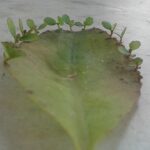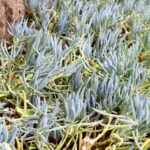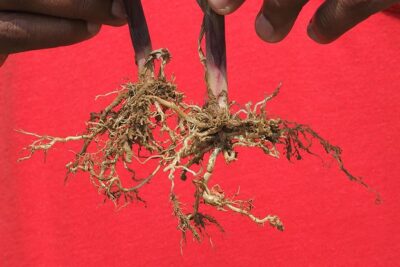
Propagating Succulents: A Guide to Using Aerial Roots for Growth

Succulents are a popular choice for indoor and outdoor gardens due to their unique appearance and low maintenance needs. These plants have adapted to survive in arid conditions by storing water in their leaves and stems, making them resilient and drought-tolerant. One interesting feature of succulents is their ability to form aerial roots, which can be used for propagation and growth. Understanding how to harness the potential of aerial roots can help succulent enthusiasts expand their collection and create new plants.
We will explore the concept of aerial roots in succulents and how they contribute to the propagation process. We will discuss the different methods of propagating succulents using aerial roots, including water propagation and soil propagation. Additionally, we will provide step-by-step instructions and helpful tips for successfully propagating succulents using aerial roots. Whether you are a beginner looking to expand your succulent collection or an experienced gardener seeking new techniques, this guide will provide valuable insights into using aerial roots for the growth of succulents.
- Use a sharp, clean knife to carefully cut a healthy aerial root from the parent plant
- Fill a small pot with well-draining soil and create a hole in the center
- Gently place the aerial root into the hole, making sure it is secure
- Water the newly potted aerial root lightly, allowing the soil to absorb the moisture
- Place the potted aerial root in a bright, indirect light location
- Monitor the moisture levels of the soil and water as needed to keep it slightly damp
- Over time, new growth should emerge from the aerial root, indicating successful propagation
- Once the new plant has established roots, it can be carefully separated from the aerial root and transplanted into its own pot
- Continue to care for the new plant as you would any other succulent, providing proper light, water, and occasional fertilization
- Frequently Asked Questions
Use a sharp, clean knife to carefully cut a healthy aerial root from the parent plant
Using a sharp, clean knife is crucial when it comes to propagating succulents through aerial roots. This ensures a clean cut that minimizes damage to the parent plant and increases the chances of successful propagation.
Aerial roots are specialized structures that some succulent species develop to absorb moisture and nutrients from the air. These roots can be found hanging from the stems or branches of the parent plant, and they play a vital role in the plant's ability to survive in arid environments.
To begin the process, identify a healthy aerial root that is long enough to be cut without harming the parent plant. Look for roots that are firm, plump, and free from any signs of damage or disease. These are indications that the root is actively absorbing nutrients and will have a better chance of developing into a new plant.
Once you have selected a suitable aerial root, carefully use the knife to make a clean cut. Make sure to sterilize the knife with rubbing alcohol or a disinfectant before and after the cut to prevent the spread of any potential diseases.
 Water Propagation: A Guide for Succulent Plants
Water Propagation: A Guide for Succulent PlantsPro Tip: It's best to make a diagonal cut at the base of the aerial root where it meets the parent plant. This creates a larger surface area for new root growth and increases the chances of successful propagation.
After cutting the aerial root, it's important to let the wound callus over before planting it. This typically takes a few days to a week, during which time the cut end of the root will dry and form a protective layer.
Once the aerial root has callused over, it's ready to be planted. Prepare a well-draining potting mix suitable for succulents, such as a mixture of cactus soil and perlite. Fill a small container with the potting mix and create a small hole or trench for the aerial root to be placed in.
Gently place the cut end of the aerial root into the hole or trench, making sure that it is securely anchored in the soil. Avoid burying the root too deep, as this can hinder its ability to develop new roots and establish itself as a new plant.
Pro Tip: If the aerial root is particularly long, you can also opt to plant it horizontally on the soil surface, allowing it to root and anchor itself naturally.
After planting, lightly water the soil to settle it around the aerial root. It's important to avoid overwatering at this stage, as succulents are prone to root rot if kept in overly moist conditions.
Place the newly planted aerial root in a bright location with indirect sunlight. Avoid placing it in direct sunlight, as this can cause sunburn and damage to the delicate root system.
 Growing Succulent Seeds at Home: A Step-by-Step Guide
Growing Succulent Seeds at Home: A Step-by-Step GuidePro Tip: If you're propagating multiple aerial roots, it's a good idea to label the pots or use different containers for each root to keep track of their progress and prevent confusion.
Over time, the aerial root will develop new roots and eventually grow into an independent succulent plant. It's important to be patient during this process, as succulent propagation can take several weeks to months, depending on the species and environmental conditions.
By using aerial roots for propagation, you can expand your succulent collection and enjoy the satisfaction of growing new plants from existing ones. With proper care and attention, your propagated succulents will thrive and bring beauty to your indoor or outdoor space.
Fill a small pot with well-draining soil and create a hole in the center
When propagating succulents, it is important to provide them with the right growing medium. Start by filling a small pot with well-draining soil. Succulents thrive in soil that allows excess water to flow out easily, preventing the roots from becoming waterlogged. You can use a commercial succulent mix or create your own by combining regular potting soil with perlite or sand to improve drainage.
After filling the pot, create a hole in the center of the soil. This is where you will place the aerial roots of the succulent, encouraging new growth and propagation. Aerial roots are specialized structures that some succulent species develop, allowing them to take up moisture and nutrients from the air.
 How to Propagate a Rock Succulent by Splitting: Step-by-Step Guide
How to Propagate a Rock Succulent by Splitting: Step-by-Step GuideChoose a healthy succulent with visible aerial roots
Not all succulents develop aerial roots, so it's important to choose a species or variety that does. When selecting a succulent for propagation, look for one with visible aerial roots. These roots may appear as thin, thread-like structures extending from the stem or as small bumps along the stem itself.
It's also essential to choose a healthy succulent with no signs of disease or damage. Inspect the leaves for any discoloration, spots, or signs of pests. A healthy succulent will have plump, firm leaves and a vibrant color.
- Choose a succulent with visible aerial roots
- Ensure the succulent is healthy and disease-free
Gently place the aerial roots into the hole and firm the soil around them
Once you have selected a suitable succulent for propagation, it's time to plant it in the prepared pot. Gently place the aerial roots into the hole you created earlier, making sure not to damage or break them. Aerial roots are delicate structures, so handle them with care.
 Can I Easily Propagate Succulents by Leaf Propagation?
Can I Easily Propagate Succulents by Leaf Propagation?After placing the aerial roots into the hole, gently firm the soil around them to provide support. Avoid packing the soil too tightly as it can restrict the roots' ability to absorb moisture and nutrients. The goal is to create a stable environment for the succulent to establish new roots and grow.
- Gently place the aerial roots into the hole
- Firm the soil around the roots
Note: It's important to keep the newly planted succulent in a warm and well-lit area but protected from direct sunlight. Water sparingly, allowing the soil to dry out between waterings. With proper care and patience, your succulent will soon establish new roots and thrive in its new pot.
Gently place the aerial root into the hole, making sure it is secure
When it comes to propagating succulents, one method that can yield great results is using aerial roots. Aerial roots are adventitious roots that grow above the ground, often from the stem or leaf nodes of the plant. These roots have the amazing ability to absorb moisture and nutrients from the air, making them a valuable asset in the propagation process.
Before you start using aerial roots for propagation, it is important to ensure that the root is healthy and strong. Look for roots that are firm, plump, and free from any signs of damage or disease. This will give your new succulent the best chance of thriving.
Step 1: Prepare a suitable potting mix
A well-draining potting mix is crucial for the successful propagation of succulents. Start by preparing a mixture of equal parts coarse sand, perlite, and well-draining potting soil. This will create a lightweight and porous medium that allows excess water to drain away quickly, preventing root rot.
Step 2: Create a small hole in the potting mix
Using your finger or a small tool, gently create a hole in the potting mix where you will insert the aerial root. Make sure the hole is deep enough to accommodate the root without bending or damaging it. Take care not to compact the potting mix too much, as this can hinder root growth.
 Water Propagation of Succulents: A Comprehensive Guide
Water Propagation of Succulents: A Comprehensive GuideStep 3: Gently place the aerial root into the hole, making sure it is secure
Hold the succulent by its stem or leaf and carefully lower the aerial root into the prepared hole. Ensure that the root is positioned vertically and is surrounded by the potting mix. Gently press the mix around the root to secure it in place, without applying excessive pressure.
Tip: If the aerial root is too long, you can trim it slightly to fit the hole. However, avoid cutting off too much as it may affect the root's ability to absorb moisture and nutrients.
Step 4: Provide proper care and maintenance
After placing the aerial root in the potting mix, it is important to provide the right care to promote healthy growth. Place the potted succulent in a bright location with indirect sunlight. Water the plant sparingly, allowing the potting mix to dry out between watering sessions. Overwatering can lead to root rot, so it's better to err on the side of underwatering.
Pro tip: Mist the aerial root occasionally with water to provide additional moisture and encourage root development.
With time and proper care, the aerial root will develop into a full-grown succulent plant. Keep an eye on the progress of the root and adjust your care routine accordingly. Before you know it, you'll have a thriving succulent that started its journey from a humble aerial root!
Water the newly potted aerial root lightly, allowing the soil to absorb the moisture
Watering the Newly Potted Aerial Root
After successfully potting your succulent using aerial roots, it's important to give it the proper care and attention it needs. One crucial step in the process is watering the newly potted aerial root. This step ensures that the succulent receives the necessary moisture for healthy growth.
 Dormancy in Succulents: A Guide to Varieties and Timing
Dormancy in Succulents: A Guide to Varieties and TimingWhen watering the aerial root, it's essential to be mindful of the amount of water you provide. Succulents are adapted to dry environments and excessive watering can lead to root rot or other issues. It's best to take a cautious approach and water the plant lightly, allowing the soil to absorb the moisture.
To water the newly potted aerial root, follow these simple steps:
- Fill a small watering can or container with room temperature water.
- Gently pour the water around the base of the succulent, avoiding direct contact with the leaves or stem.
- Allow the water to soak into the soil for a few minutes.
- Check the moisture level by inserting your finger about an inch into the soil. If it feels moist, wait until the top layer dries out before watering again.
Remember, succulents have unique water requirements, and their watering needs may vary depending on factors such as the season, humidity levels, and the type of succulent. It's crucial to monitor the plant's moisture levels and adjust your watering routine accordingly.
By providing the right amount of water to the newly potted aerial root, you're giving your succulent the best chance to establish itself and thrive in its new environment. Remember to always observe your succulent closely and make adjustments to your care routine as needed.
Pro tip: If you're unsure about the watering needs of your succulent, it's always better to underwater than overwater. Succulents are more tolerant of drought than excessive moisture.
Place the potted aerial root in a bright, indirect light location
When propagating succulents using aerial roots, it is crucial to provide them with the right amount of light. A bright, indirect light location is the perfect spot for your potted aerial root to thrive. Avoid placing it in direct sunlight as succulents are known to burn easily when exposed to intense light.
Position the potted aerial root near a window or in a well-lit area of your home. This will ensure that it receives adequate light without being subjected to harsh rays. If you notice that the succulent is stretching or leaning towards the light source, it may be an indication that it is not receiving enough light. In this case, consider moving it closer to the window or providing supplemental lighting.
 Can Succulent Cuttings Be Planted Directly in Soil?
Can Succulent Cuttings Be Planted Directly in Soil?Remember, succulents are adapted to survive in arid conditions, so they do not require as much sunlight as some other plants. However, providing them with sufficient light is essential for their growth and overall health.
Monitor the moisture levels of the soil and water as needed to keep it slightly damp
When propagating succulents using aerial roots, it is crucial to pay attention to the moisture levels of the soil. Succulents are known for their ability to store water in their leaves, stems, and roots, making them highly adapted to dry environments. However, during the propagation process, it is important to ensure that the soil remains slightly damp to promote root growth.
To monitor the moisture levels, gently insert your finger about an inch into the soil. If the soil feels dry at this depth, it is an indication that it is time to water the plant. Use a watering can with a narrow spout to direct the water towards the base of the plant, avoiding the leaves and stems.
It is important not to overwater the succulent, as excessive moisture can lead to root rot and other potential issues. Overwatering can inhibit the development of aerial roots and slow down the growth process. Remember that succulents thrive in well-draining soil, so it is essential to allow the soil to dry out partially between waterings.
Pro Tip: A good way to ensure proper drainage is to use a pot with drainage holes at the bottom. This will allow excess water to escape and prevent waterlogging.
Over time, new growth should emerge from the aerial root, indicating successful propagation
 Propagation of Succulents: Cutting Techniques and Methods
Propagation of Succulents: Cutting Techniques and MethodsWhen it comes to propagating succulents, using aerial roots can be an effective method to encourage healthy growth. Aerial roots are specialized structures that some succulents develop to absorb water and nutrients from the air. By taking advantage of these roots, you can increase your chances of successfully propagating your succulents.
What are aerial roots?
Aerial roots, also known as adventitious roots, are roots that develop above the ground, typically originating from the stem or leaves of a plant. Succulents such as epiphytic cacti and some orchids are known for their ability to produce aerial roots. These roots serve as a means for the plant to obtain additional moisture and nutrients from the atmosphere.
How to propagate succulents using aerial roots
To propagate succulents using aerial roots, follow these simple steps:
- Select a healthy parent plant: Choose a succulent that has well-developed aerial roots. This indicates that the plant is mature and capable of producing offspring.
- Identify a suitable stem or leaf: Look for a stem or leaf that has visible aerial roots. These roots will be instrumental in the propagation process.
- Prepare a suitable growing medium: Use a well-draining soil mix specifically formulated for succulents. This will ensure that the roots have access to the necessary nutrients while avoiding overwatering.
- Make a clean cut: Using a sterilized knife or scissors, carefully cut a portion of the stem or leaf with the aerial roots intact. Ensure that the cutting is done neatly to minimize damage to the parent plant.
- Plant the cutting: Gently place the cutting with the aerial roots into the prepared growing medium, making sure to bury the roots slightly. This will provide stability and allow the roots to establish contact with the soil.
- Provide adequate care: Place the propagated cutting in a location with bright, indirect sunlight. Water sparingly, allowing the soil to dry out between waterings. It is essential to avoid overwatering, as this can lead to root rot.
- Monitor growth: Over time, new growth should emerge from the aerial root, indicating successful propagation. Keep an eye on the plant's progress, and adjust care as needed.
Benefits of using aerial roots for succulent propagation
Utilizing aerial roots for succulent propagation offers several advantages:
- Increased success rate: Aerial roots are natural and developed by the plant itself, making them an ideal tool for propagation.
- Faster growth: Aerial roots absorb nutrients directly from the air, allowing the propagated succulent to grow at a faster rate.
- Stronger root system: By utilizing aerial roots, the propagated succulent develops a robust root system, ensuring its long-term health and survival.
- Exploration of new growth: Propagating succulents using aerial roots allows you to witness the emergence of new growth, adding an exciting element to your gardening experience.
By understanding the benefits of using aerial roots and following the proper propagation techniques, you can successfully propagate your succulents and expand your collection with healthy, thriving plants.
Once the new plant has established roots, it can be carefully separated from the aerial root and transplanted into its own pot
Once the new plant has established roots, it can be carefully separated from the aerial root and transplanted into its own pot.
 Succulent Root Growth: Unveiling Patterns and Depths
Succulent Root Growth: Unveiling Patterns and DepthsTransplanting succulents that have grown from aerial roots is an exciting process that allows you to propagate and expand your succulent collection. By understanding how to use aerial roots for growth, you can successfully propagate your succulents and create a beautiful indoor garden.
Aerial roots are specialized structures that certain succulent species develop to anchor themselves to surfaces and absorb nutrients from the air. These roots are different from traditional roots that grow underground and are essential for the survival and growth of the plants.
When a succulent develops aerial roots, it is a sign that it is ready for propagation. This means that the plant has reached a stage where it can be separated from the parent plant and grown independently.
Steps to Propagate Succulents Using Aerial Roots:
- Identify the aerial roots: Carefully inspect your succulent plants for any aerial roots that have developed. These roots usually appear as thin, thread-like structures extending from the main stem or leaves.
- Prepare the new pot: Choose a small pot with good drainage holes to transplant the new succulent. Fill it with well-draining soil suitable for succulents.
- Separate the succulent: Gently hold the succulent near the base and carefully detach it from the aerial root. Be cautious not to damage the newly formed roots.
- Plant the succulent: Create a small hole in the prepared pot and place the succulent inside, ensuring its roots are covered with soil. Press the soil gently to secure the plant in place.
- Provide the ideal conditions: Place the potted succulent in a location with bright, indirect sunlight. Avoid direct sunlight as it can cause sunburn on the delicate leaves.
- Watering: Allow the soil to completely dry out between waterings to prevent overwatering and root rot. Succulents prefer infrequent but deep watering.
- Monitor growth: Regularly observe the new succulent for signs of growth, such as the emergence of new leaves or roots. This indicates that the plant has successfully established itself in its new pot.
By following these steps, you can effectively propagate succulents using aerial roots. Remember to be patient and provide the necessary care to ensure the success of your new succulent plants.
Continue to care for the new plant as you would any other succulent, providing proper light, water, and occasional fertilization
Once you have successfully propagated your succulent using aerial roots, it is important to continue providing it with the care it needs to thrive. Although the propagation process might be over, this doesn't mean that your job as a plant parent is done. Proper light, water, and occasional fertilization are still essential for the growth and health of your new plant.
Light Requirements
Succulents, including those propagated using aerial roots, generally require bright but indirect sunlight. Place your new plant in a location where it can receive around 6-8 hours of sunlight each day. However, be cautious of exposing it to direct sunlight for extended periods, as this can lead to sunburn and damage the plant.
 Growing Blue Bean Succulents: A Guide for Home Gardeners
Growing Blue Bean Succulents: A Guide for Home GardenersConsider placing your succulent near a window that receives filtered sunlight or use sheer curtains to provide some shade. If you notice your plant stretching or leaning towards the light source, it might be an indication that it needs more sunlight, in which case, you can gradually increase its exposure.
Watering
Proper watering is crucial for succulent care, and your propagated plant is no exception. Aim to water your succulent when the soil is completely dry. Overwatering can lead to root rot and other issues, so it's important to avoid leaving the plant sitting in water or keeping the soil excessively moist.
When watering, thoroughly soak the soil until water drains out of the bottom of the pot. Allow the soil to dry out completely before watering again. The frequency of watering will depend on various factors such as the climate, pot size, and the type of succulent, so it's always best to monitor the plant's needs and adjust accordingly.
Occasional Fertilization
While succulents are known for their ability to thrive in nutrient-poor soils, providing some occasional fertilization can benefit their growth. However, it's important to use a well-balanced, diluted fertilizer specifically formulated for succulents.
During the active growing season, which is typically spring and summer, you can fertilize your propagated succulent once every 2-4 weeks. Follow the instructions on the fertilizer packaging to ensure you're using the correct amount. Avoid over-fertilizing, as this can lead to excessive growth or nutrient burn.
By continuing to care for your propagated succulent with proper light, water, and occasional fertilization, you are setting it up for success. Remember to monitor the plant's needs and make adjustments as necessary. With proper care, your succulent will continue to thrive and bring beauty to your indoor or outdoor space.
Frequently Asked Questions
1. What are aerial roots in succulents?
Aerial roots in succulents are roots that grow above the ground, providing additional support and absorbing moisture from the air.
2. How do succulents use aerial roots for growth?
Succulents use aerial roots to anchor themselves onto surfaces and absorb moisture from the air when the soil is dry.
3. Can all succulents develop aerial roots?
No, not all succulents develop aerial roots. It depends on the species and the conditions in which they are growing.
4. How can I encourage aerial root growth in my succulents?
To encourage aerial root growth, you can provide a well-draining soil mix, expose the succulents to bright light, and avoid overwatering.
If you want to read more articles similar to Propagating Succulents: A Guide to Using Aerial Roots for Growth, you can visit the Propagation category.






You Must Read